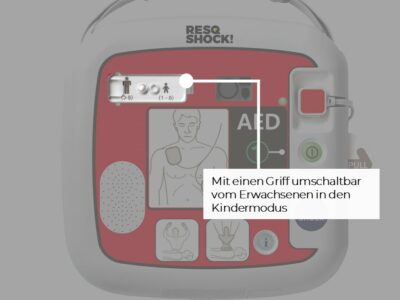- Home
- Blog
- Resuscitation for infants and children
Resuscitation for infants and children
That's how it works!
Resuscitation for infants and children includes cardiac massage and rescue breathing, just as for adults. Performed in time, it can save the child's life in the event of respiratory and circulatory arrest! Learn here how to resuscitate infants and children and what the differences are to resuscitation for adults!
Cardiopulmonary resuscitation is performed whenever unconsciousness and no normal breathing can be detected or there is doubt that normal breathing is present.
Due to the higher risk of foreign bodies obstructing the airway in children and infants, up to five initial rescue breaths should be given before starting chest compressions. If a rescue breath cannot be given, only chest compressions are given.
For children
- If no mobile phone available, 1 minute of CPR before alerting
- Start with 5 ventilations
- Ratio 15 compressions to 2 ventilations (for single or lay rescuers: 30:2)
- Compression depth 1/3 chest diameter.
Reanimation baby

Baby" or "infant" means children up to the end of the first year of life. When resuscitating them, proceed as follows:
Check
reaction
Check whether the baby reacts, preferably by giving a mild pain stimulus. For example, you can gently pinch the baby on the inside of the upper arm.
Supine position
Lay the baby flat on its back, preferably on a hard surface.
Head in neutral position
Put the baby's head in a normal, i.e. neutral position (do not overstretch!).
Check breathing
Hold the baby's chin with two fingers. Then, with the airway open, place your ear over the baby's mouth and nose to hear any breathing sounds. While listening, direct your gaze to the baby's chest to detect any breathing movements.
5 breaths at the beginning
If the baby is not breathing or not breathing properly, or if you are unsure about this, you should give him or her artificial respiration immediately, using the mouth and nose at the same time: start with five breaths.
15 x chest compressions
After the five breaths, place two fingers in the centre of the baby's sternum and press down. Repeat this 15 times at a rate of about 100-120 per minute (to do this, press on the baby's sternum about twice per second). This is how it is recommended for experienced helpers. Untrained rescuers who are only familiar with adult resuscitation may also be able to perform chest compressions 30 times as recommended for adults.
Breath giving and chest compressions alternately
Now give breath twice more before giving chest compressions again (experienced rescuers: 15 times; untrained rescuers 30 times if necessary). Continue this 15:2 cycle (or 30:2 cycle) until either the rescue service arrives or the baby is breathing on its own again.
Child resuscitation (from one year)

Cardiopulmonary resuscitation (chest compressions and ventilation) for children over one year of age is similar:
Open the airway and check breathing
Proceed as with babies. However, for children over one year of age, you can slightly overstretch the head if necessary.
5 breaths at the beginning
Start the ventilation (as with babies) with five breaths. In young children, give breaths through the mouth and nose at the same time; in older children, give breaths through the mouth or nose.
15 xchest compressions
Perform chest compressions 15 times (30 times if you are an untrained rescuer) by rhythmically pressing on the centre of the child's chest with the heel of your hand. As with babies, a frequency of about 100-120 per minute is recommended, i.e. about twice per second.
Alternate rescue breaths andchest compressions
Continue rescue breaths and chest compressions alternately. Experienced rescuers should follow the 15:2 cycle (15 chest compressions and 2 ventilations alternately), just like medical staff. Untrained rescuers may also use the 30:2 cycle known from adult resuscitation. Do not stop resuscitation until the ambulance arrives or the child starts breathing again.
Chest compressions and ventilations (CPR)
Thoracic compression technique
- Infants: two-thumb technique (several helpers) or two-finger technique (single helper)
- Children: Compression with the ball of the hand
- Compress thorax by one third of its anteroposterior diameter
- Complete relief after each compression
Compression-ventilation ratio
- Trained first aiders: 15:2
- Individual or lay helpers: 30:2
Trained first responders are advised to use a 15:2 cycle (15 times chest compressions and 2 ventilations alternately) instead of the 30:2 cycle used for adults.
At a ratio of 15:2, more ventilations are performed, while at a ratio of 30:2, more chest compressions are performed.
CPR frequency: 100-120/min. Avoid interruptions (max. 10 s)
Child or already an adult?
Who looks grown-up, or (tip from our expert) if you think "is that still a child or already grown-up?" when you come in. - Adult algorithm with 30:2.
AED insert (as soon as available)
Every 2 min Rhythm analysis and defibrillation if necessary
Age-dependent application
- Children from 8 years old: Use pads and settings as for adults
- Kindern <8 Jahren (bzw. <25Kg): Kindermodus (Leistungsminderer) verwenden


